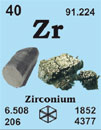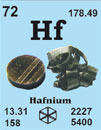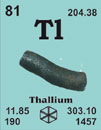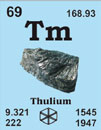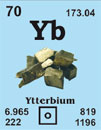Zink 30Zn65.37
In Indien und CHina vor 1500 bekannt.
[Zink kommt von Zinken = zackenartige Formen]
French: zinc
English: zinc
Italian: zinco
Spanish: cinc
Beschreibung: Bläulichweißes Material, spröde, wenn gegossen. Läuft in Luft an, reagiert mit Säuren und Alkalien. Verwendet zum Galvanisieren von Eisen, in Legierungen, z. B. Messing, in Batterien, als ZnO im Gummi und als Stabilisator für Polymere.
Zink single crystal properties
| State: |
single crystal |
|---|
| Crystal structure: |
hexagonal |
|---|
| Production method: |
Bridgman |
|---|
| Standard size: |
diameter 10-20mm
thickness 1-2mm |
|---|
| Orientation: |
(1001), (1-100) and (11-20) |
|---|
| Orientation accuracy: |
<2°, <1°, <0.4° or <0.1° |
|---|
| Polishing: |
as cut, one or two sides polished |
|---|
| Roughness of surface: |
<0.03µm |
|---|
| Purity: |
99.999% |
|---|
| Typical analysis (ppm): |
C 3
H < 1
O 9
N < 5
Cu 1.60
Fe 1.80
Ni < 1
Pb 0.30
Si 0.30
Ga, Hf and Ta are below the detection limit
|
|---|
Materials properties
| Density: |
7.14 g/cm3 |
|---|
| Melting point: |
419.58 °C / 692.73 °K |
|---|
| Boiling point: |
906.85 °C / 1180 °K |
|---|
| Molar volume: |
9.17 cm3 |
|---|
| Thermal conductivity: |
116 [300 K] Wm-1K-1 |
|---|
| Coefficient of linear thermal expansion: |
25.0 x 10-6 K-1 |
|---|
| Electrical resistivity: |
5.916x 10-8 [293 K] Wm |
|---|
| Mass magnetic susceptibility: |
-2.20 x 10-9(s) kg-1m3 |
|---|
| Young's modulus: |
104.5 GPa |
|---|
| Rigidity modulus: |
41.9 GPa |
|---|
| Bulk modulus: |
69.4 GPa |
|---|
| Poisson's ratio: |
0.249 GPa |
|---|
| Radii: |
Zn2+ 83; atomic 133; covalent 125 |
|---|
| Electronegativity: |
1.65 (Pauling); 1.66 (Allred); 4.45 eV (absolute) |
|---|
| Effective nuclear charge: |
4.35 (Slater); 5.97 (Clementi); 8.28 (Froese-Fischer) |
|---|
| Number of Isotopes (incl. nuclear isomers): |
23 |
|---|
| Issotope mass range: |
57 -> 78 |
|---|
| Crystal structure, (cell dimentions / pm), space group |
hexagonal |
|---|
| X-ray diffraction: mass absorption coefficients: |
CuKα 60.3 (µ/r) / cm2g-1
MoKα 55.4 (µ/r) / cm2g-1 |
|---|
| Neutron scattering length: |
0.5680 b/10-12 cm |
|---|
| Thermal neutron capture cross-section: |
1.11 sa / barns |
|---|
Biological data
| Biological role: |
Essential for all species |
|---|
| Toxicity |
|
|---|
| Toxic intake: |
generally regarded as of low toxicity |
|---|
| Lethal intake: |
LD50 (chloride, oral, rat) = 350 mg kg-1 |
|---|
| Hazards: |
Zinc metal is a human skin irritant but otherwise is non-toxic and so are most common compounds; however, zinc salts have been shown to be experimental carcinogens. |
|---|
| Level in humans |
|
|---|
| Blood: |
7.0 mg dm-3 |
|---|
| Bone: |
75 - 170 p.p.m. |
|---|
| Liver: |
240 p.p.m. |
|---|
| Muscle: |
240 p.p.m. |
|---|
| Daily dietary intake: |
5 - 40 mg |
|---|
| Total mass of element in average [70 kg] person: |
2.3 mg |
|---|
Geological data
| Mineral | Formula | Density | Hardness | Crystal apperance |
|---|
| Hemimorphite |
Zn4Si2O7(OH)2.H2O |
3.475 |
4.5 - 5 |
orth., vit./pearly white |
|---|
| Hydrozincite |
Zn5(CO3)2(OH)6 |
4.00 |
2 - 2.5 |
mon., earthy/silky white etc. |
|---|
| Sphalerite |
ZnS |
4.08 |
3.5 |
cub., yellow to brown |
|---|
| Smithsonite |
ZnCO3 |
4.2 |
4 - 4.5 |
rhom., vit. grey-white |
|---|
| Willemite |
Zn2SiO4 |
4.1 |
5.5 |
rhom., vitreous-resinous, white/pale green |
|---|
| Chief ore: |
sphalerite (with cadmium, gallium and indium as by-products), smithsonite, hemimorphite. Hydrozincit |
|---|
| World production: |
5.02 x 106 tonnes/year |
|---|
| Main mining areas: |
USA, Canada, Australia, Austria, Russia, Turkey |
|---|
| Reserves: |
110 x 106 tonnes |
|---|
| Specimen: |
available as dust, foila, granules, pieces, powder, shot, sticks and wire. Safe. |
|---|
| Abundances |
|
|---|
| Sun: |
2.82 x 104 (relative to H = 1 x 1012) |
|---|
| Earth's crust: |
75 p.p.m. |
|---|
| Seawater: |
|
|---|
| Residence time: |
|
|---|
| Classification: |
recycled |
|---|
| Oxidation state: |
II |
|---|

 English
English
 Deutsch
Deutsch








































